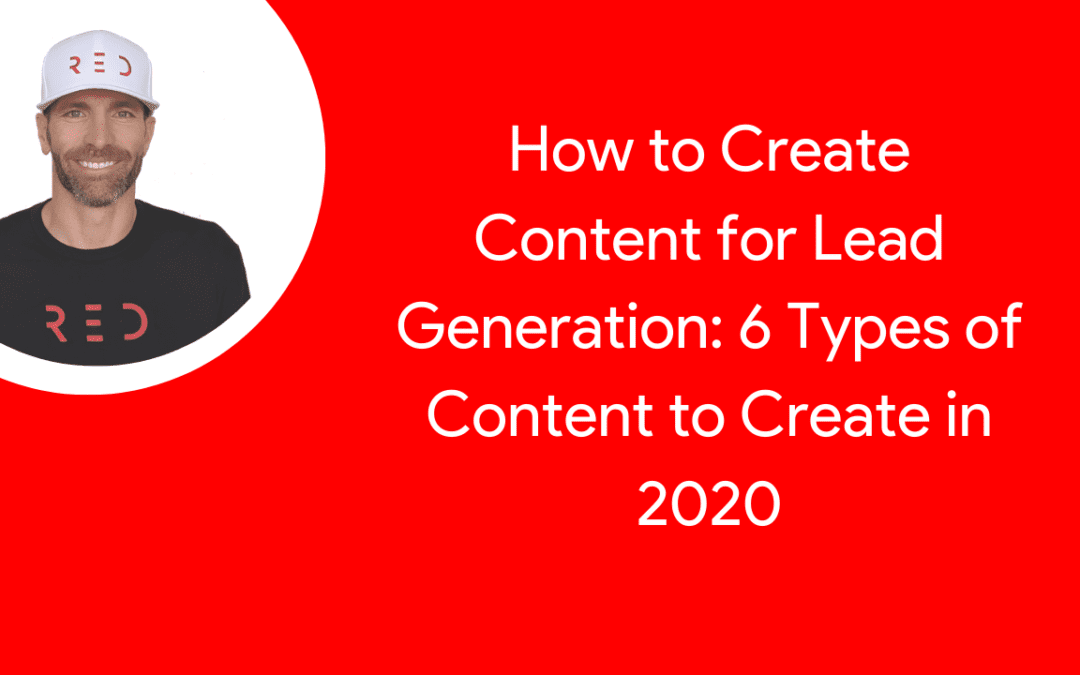How businesses generate leads has changed since the advent of content marketing.
Online advertising still works great, but if you’re operating on a tight budget, you can still acquire leads just by creating helpful content and distributing it for free.
Content is key when you’re looking to attract qualified leads.
Aside from paid ads, savvy marketers incorporate new types of content into their strategy.
If your audience loves listening to your podcasts, you should create more of it but that doesn’t mean that’s the only content format you should create. Fresh content types can educate and inspire your audience, and possibly result in better leads.
To help you kick start your content strategy and generate leads, you’ll discover the 6 types of content to create in 2020.
It’s all about infusing a variety of content formats behind a landing page to help you collect new leads.
But before we dive into these content formats, follow these simple to start generating leads from your content:
How businesses generate leads has changed since the advent of content marketing.
Online advertising still works great, but if you’re operating on a tight budget, you can still acquire leads just by creating helpful content and distributing it for free.
Content is key when you’re looking to attract qualified leads.
Aside from paid ads, savvy marketers incorporate new types of content into their strategy.
If your audience loves listening to your podcasts, you should create more of it but that doesn’t mean that’s the only content format you should create. Fresh content types can educate and inspire your audience, and possibly result in better leads.
To help you kick start your content strategy and generate leads, you’ll discover the 6 types of content to create in 2020.
It’s all about infusing a variety of content formats behind a landing page to help you collect new leads.
But before we dive into these content formats, follow these simple to start generating leads from your content:
1. Define Your Keywords
Many marketers assume keyword research is just about Google and understanding which words your potential customers or leads type into the search box. But keyword research can also be based on social media behavior (understanding how people discuss your topic on social media) — Ann Smarty
It doesn’t matter the type of content you choose to create for lead generation, you have to begin with keywords. You want to be able to address a particular question or query that your audience is searching on Google.
The keyword research process is important. It should be an integral part of your content strategy. Don’t neglect or do it by the side.
Behind every query you find, there’s a specific intent that a searcher had when they entered it into the search box.
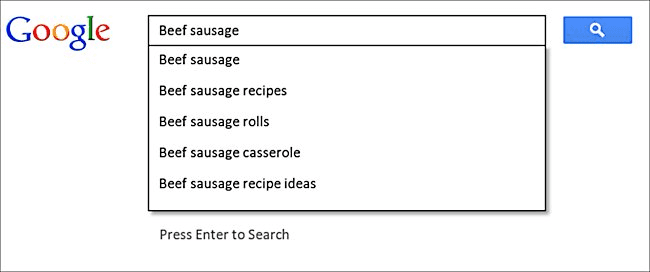
So when you conduct keyword research, you should think of it as market research or competitive analysis. One of the best ways to acquire leads is by getting inside their minds.
You have a responsibility to deliver the right content that addresses their needs and solves a particular problem – that’s why targeting the right keywords is critical to your lead generation success.
In-depth keyword research will help you to uncover ideas and perspectives you never imagined.
Your potential customers can give you direction as to what type of content to create, how to structure it, and the language to speak so they understand you better.
Keywords research also helps you to know what your competitors are doing, what keywords they’re ranking for, how they’re targeting these keywords, and the type of content they’re creating.
Since we’re mostly concerned about lead generation, it means you’ve to focus on keywords that will drive ‘Top of the Funnel’ traffic. These should be mid-traffic information keywords that may not have any commercial intent.
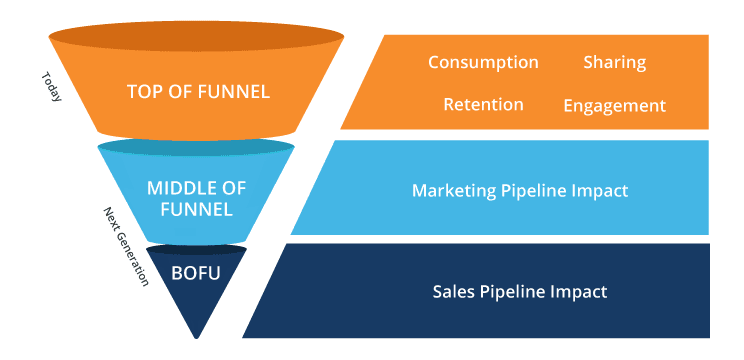
For example, if you’re selling running shoes, some of the long-tail informational keywords that will drive traffic are:
- How to determine shoe size
- Do running shoes fit?
- Running shoes vs workout shoes
These informational keywords will have less competition but they’re the exact questions beginners in your industry will be asking. These people aren’t ready to buy a running shoe yet, but as you educate them, they’ll begin to consider getting a running shoe.
That consideration stage of the funnel is where you’ll target keywords with commercial intent. For example:
- How to buy running shoes online
- Which running shoes should a beginner buy
- Running shoe size guide
Regardless of the keywords you choose, you want to make sure it appears in your headline. Here are some headline ideas for blog posts, videos, or even eBooks:
- How to Determine Shoe Size: The Beginner’s Guide
- Do Running Shoes Fit (Honest Answer and Checklist)?
- Running Shoes Vs. Workout Shoes (What is the Difference)?
2. Use Gated Content Strategy
What is gated content?
Gated content is a type of online material or tool, such as videos, white papers, articles, and software that require the target audience to fill out a form before they can access them. It could be a simple form asking for the basics such as name and email address, or multiple form fields that ask for the user’s personal and company data.
Here’s a good example of a Gated content:
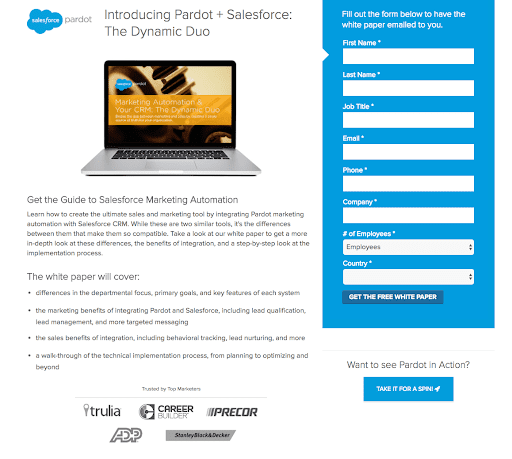
An important step in your lead generation campaign is how you increase the desire for your content.
If you want people to want to access your eBook, for example, you have to increase the perceived value. A simple way to do this is by ‘gating’ your content. It’ll convert your landing page visitors into subscribers and leads.
More importantly, you can gauge quality leads by the actions they take. For example, someone who fills out a form to download your eBook is more qualified than a site visitor who reads your blog posts (un-gated) and clicks the back button on your browser.
The former has visited your site, probably read your posts, and have chosen to request more information with their contact details. That’s remarkable!
By simply entering their email address and name, they’ve proven that your content is worth it and your product could be what they’re looking for.
This may not seem like much, but considering the average human’s attention span is decreasing (less than that of a goldfish), every second that a potential customer or reader spends on your website is valuable.

If they fill out a form to get your information, that’s a bigger commitment of their time and resources.
So, a great way to qualify your leads is by asking them to fill out a form before downloading your white paper, eBook, or before watching your tutorial videos.
If you’re in the B2B niche, it’s always ideal to ask for more information. The name and email address may be useful for following up, but it doesn’t say much.
Marketo, a B2B marketing firm asks for the prospect’s job role, company name, how many employees work in their organization, annual revenue, etc.
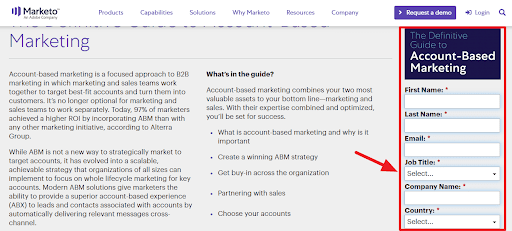
These questions are important if you want to engage with potential leads that are more likely to become customers.
3. Convert Leads into Customers
Truly, you need to make this an important part of your lead generation strategy. Don’t just focus on acquiring new leads, put measures in place to nurture and convert them into customers. That should be the end goal.
The B2B sales pipeline is usually long.
Although you should make attempts to close leads earlier, the focus should always be to educate and build trust with them — this is crucial because 50% of the leads aren’t ready to buy, according to Gleanster Research.
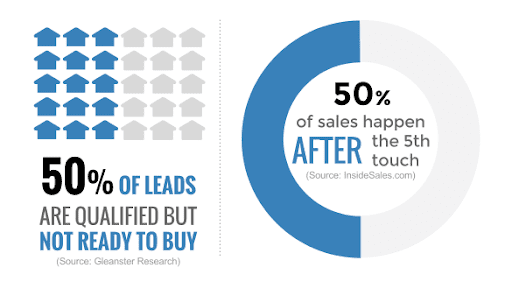
Getting a B2B lead to buy your product can take weeks or even months — that’s because they (for example, a CEO) need to think it through, meet with the administrative team to discuss how much your product can help their bottom line.
Only then will they take the step to buy.
So take the time to nurture your leads. Create helpful content that answers their questions.
Once you’ve captured their contact information + other info, you need to start sending relevant value-packed emails at regular intervals. It could be every 2 days or twice per week.
If your leads signed up for your webinar this week, you need to connect with them after the live webinar.
Ask them to share their questions and challenges (if any). They’ll likely forget you ever existed if you don’t get back to them within 7 days.
Using email marketing solutions such as Active Campaign, ConvertKit, or MailChimp, you can schedule automated emails, automate procedures to save time, offer relevant content and persuasive content, and keep your brand in their minds — pending when they’re ready to buy your product.
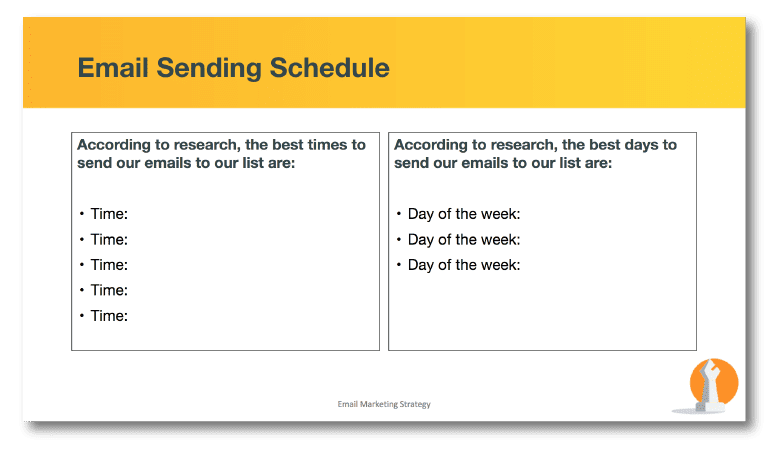
We’ll discuss some of the best content you should use to nurture your leads. Just bear in mind that the type of content matters little as much as the value it delivers.
For example, videos are viewed as good content formats, but if you can create a detailed and actionable blog post, your leads might gain a lot from it.
4. Measure Your Content Performance
Unlike offline marketing channels (TV, Magazine, Radio) that rely on assumptions, you can measure every digital marketing action.
And this is crucial to your business. Knowing how your content is performing across your chosen channels will help you to make informed decisions.
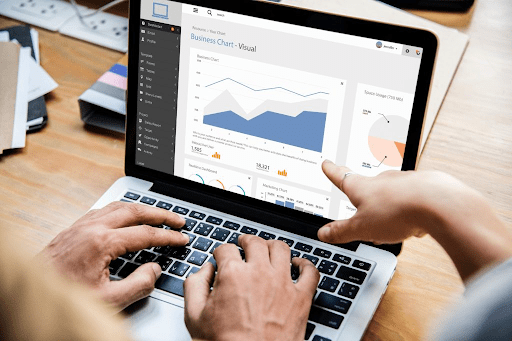
Is your content driving leads for your business?
If you’re unable to answer “YES” to that question, then you need to rethink your strategy. Beyond the brand awareness and traffic to your site, what metrics matter to your bottom line.
Here at Reddmg, we love to measure everything. We provide insightful data that helps to analyze what campaigns worked, what didn’t, and how best we can optimize campaigns to increase conversions.
Before creating a piece of content (blog post, eBook, white paper), make sure you have a goal or an objective of what it should accomplish. Do you want business executives to download the white paper and call your company?
If you get 5 calls from founders or business managers, then that could be a successful campaign.
But when you don’t have an objective before creating your content, even landing a deal worth $100,000 may not be regarded as a successful campaign.
So the best way to measure your content ROI is to first define what it your content should accomplish. If you’re creating YouTube videos, what do you want it to accomplish?
6 Types of Content for Lead Generation (for 2020)
Now that you have a complete idea of what your content should accomplish, why keyword research is important, and why you must use gated content strategy, it’s time to dive into the content types for 2020.
1). Contests
You didn’t see this coming… but contests are still underutilized content format you should leverage in 2020. Not too many businesses and marketers hosting contests.
Contests are important because they can reveal a lot about your audience while building trust with them. It’s a proven way to drive lots of traffic to your website, generate leads, and sales.
There’s no limit to what you can give away in your contest. Hydro Flask, for example, gave away a 32-oz Hydro Flask, the giveaway is in celebration of 200,000 Instagram followers, and to gain more.
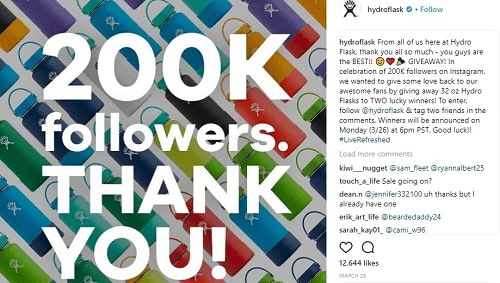
In addition to gaining new Instagram followers, their posts also garnered more than 12,500 likes. It was indeed a successful giveaway campaign, based on the company’s objective.
Depending on the goal of your contest, you can run it on your website, or leverage any social media platform — such as Twitter, Facebook, Pinterest, and Instagram. They can be simple contests or as complicated as you’d like.
The rules of contests are not set on a stone. You can be flexible with yours. But make sure it’s simple; just a few clicks to join participate. And keep the focus in mind… to capture leads and send them to your funnel.
2. Insightful Guides
How many guides did you create this year?
Guides are pillar content. They project your website/blog for massive growth in the future. They’re the type of content that Google naturally index and rank high in its organic results.
Users, on the other hand, can’t resist a good insightful guide. Here’s Impactbnd giving away a “Content Marketing Defined Guide” to its users and capturing their contact information.
Once they click the “GET MY GUIDE” button, a popup with form appears asking the user to fill out their name and email address.
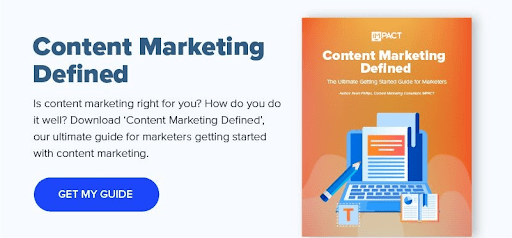
Ultimate guides are detailed, rich, long, and data-driven. You might have seen or even read a guide with plenty of screenshots, statistics, step-by-step instructions, and expert quotes.
Shorter guides are concise, shorter, and can be used as lead magnets as well.
You should create more insightful guides come 2020. Because your potential customers love to get all the information they need in one material. They don’t want to download 3 eBooks before knowing how to start a dropshipping business, for example.
3. Actionable Blog Posts
Blog posts may be the most common types of on-site content, but their effectiveness in driving leads and trust can never be undermined.
Companies can allot adequate time to creating actionable blog posts generate a lot of leads. According to HubSpot, companies that produce consistent blog posts generate 126% more leads and 55% more site traffic than non-blogging companies.
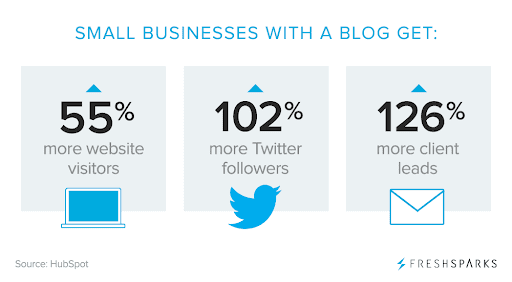
But the traditional blog posts are boring. I’m sure you’ve seen them on a company’s blog — they’re boring, short, low-quality, and not attractive.
You can change all of that in 2020 by creating high-quality and actionable blog posts that users can implement right away. If your blog post is about ‘bringing back abandoned customers to online store,” then you must not tell stories.
Offer eCommerce entrepreneurs that practical answer. Share tips and tactics they can implement right away to get results.
Did you notice that blog posts are natural organic search magnets? I mean, Google ranks blogs (especially WordPress-powered) easily. Even better than videos and images.
To amplify your blog post’s ability to generate leads, don’t just publish and pray. Promote it and make sure you include a “Content Upgrade” within the post.
Content upgrades can increase your leads by 49.9% as it did for Holler Box. Here’s an example of a content upgrade within a blog post:
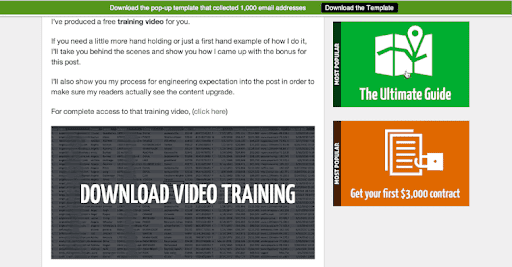
Adding a content upgrade within your blog post is a better way to build your email list than simply saying “sign up for my newsletter,” because you’re offering more relevant and specific information that the reader/visitor wants at that very second.
4. Helpful Ebooks
Another type of content that works well for lead generation is eBooks. As long as they’re perceived as being helpful, users will want to read it.
If you don’t want to make a particular topic accessible for free on your blog, then you can package it as an eBook (PDF) format and gate it. It’s a great way to explain a complex topic to an interested audience.
FlyWheel gives away a helpful eBook (I have read it) to help agencies scale.
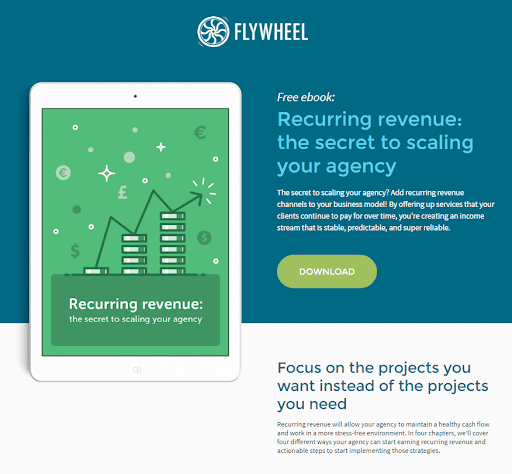
Make sure the topic can be easily digested, otherwise the user may be disappointed after subscribing to your list and quickly unsubscribe.
If the topic is qualified to be packaged in an eBook format, then you should not be concerned about making instant sales. There’s no need to plaster your product link throughout the pages. You’ve captured their name and email address already, allow them to enjoy the eBook.
Then at the backend, through your email autoresponder solution, you can follow up with ‘leading information’ to engage and convert leads into customers. That’s how effective marketing is deployed in these modern times.
5. SlideShare Presentations
Just like contests, presentations are powerful types of content for creating brand awareness and capturing leads.
SlideShare currently has over 80 million users and 17% of B2B marketers use the platform for product launches. And users add 400,000 new slides each month.
Based on these traffic numbers, B2B marketers generate leads from the platform, according to this study.
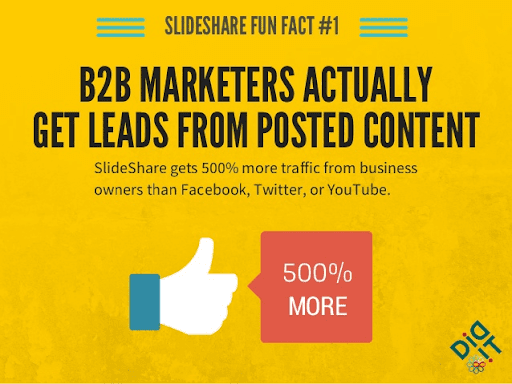
It’s still very much underutilized. If you’re going to stand out in the crowd in 2020 with your content marketing efforts, you need to start creating slide presentations.
If you already have keynote presentations, you can upload and share it on SlideShare.net.
It’s completely free and the rules aren’t as strict as YouTube and Facebook. You can create a 100% promotional presentation and it’ll be published on this platform.
The secret is in your visuals — if your presentations are colorful, professionally designed, and contains useful information, you’ll build a loyal community on the SlideShare platform.
What topics are complex in your industry or field? Break it down into separate slides and professionally package it.
Once you upload it to SlideShare, you should promote it (tweet on Twitter and share on Facebook). Get the word out and you’ll be amazed by the amount of traffic and leads it’ll drive to your business.
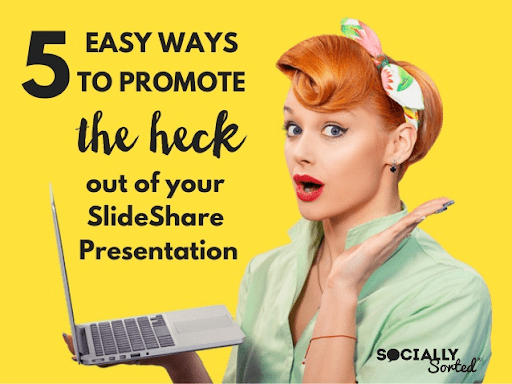
More importantly, make sure your embedded links in the slides are clickable. As much as possible, create a detailed slide presentation (20 – 100 slides) — just like YouTube videos, the longer the better, especially for engagement.
Even though SlideShare Presentations are free to create, that doesn’t mean you can use them as gated content to generate leads. If you’re smart, you can do it.
Here’s a good example from Collinson Group. What they’re giving away is a SlideShare presentation and they’re asking users for their contact information. This is smart, and you should do it if you’re confident in the value of your presentation.
As you can see, the company uses bullet points to outline what the user will gain from downloading the material.
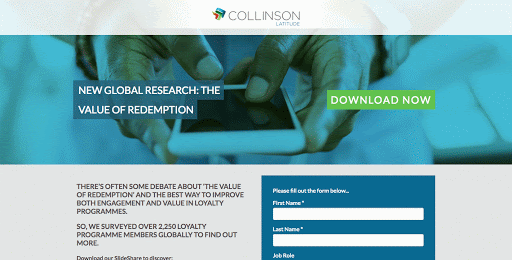
6. Editable Templates
Another type of content that works great for lead generation is editable templates.
Templates can save users time and help them to create original campaigns on their own.
You can offer editable templates in different forms — Worksheets, Calendar, and Outlines can be useful to beginners. Filestage offers a Buyer Persona Template at no cost, once the user fills out a form.
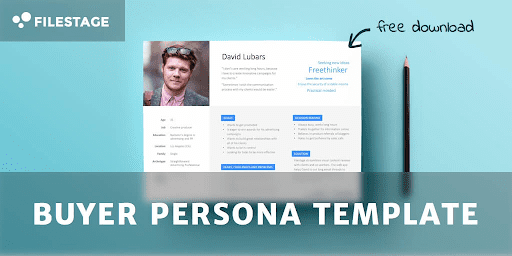
The beauty of templates is how fun it can be promoting it.
You can promote it within your blog posts (as a content upgrade), embed a download link in your eBook or white paper, share the screenshot in your YouTube video, mention it in your podcast, or create a separate landing page for it.
There’s no best technique for promoting templates. Just leverage all the techniques you’re already familiar with and you’ll be able to reach more people.give new readers something to opt-in for.
Conclusion
Content marketing is the lifeblood of today’s online marketing businesses.
If you’re ever going to thrive and not get knocked down by your competition, you need to invest your resources on great content.
For the best results, the topics you write about in your posts, eBooks, white papers, or record in your video must be what users truly want.
For example, if you’re a financial company, stop talking about mortgages and how to borrow money, but instead discuss interesting topics like how to remodel a home on a budget, why personal savings is important, how to buy a home with bank’s money, you get the drill?
Those are topics your customer really cares about.
The content type that works best for lead generation must answer questions (remember keyword research) and build trust.
Focus on your potential customers — talk about them, their problems, and what solutions you bring to the table.

